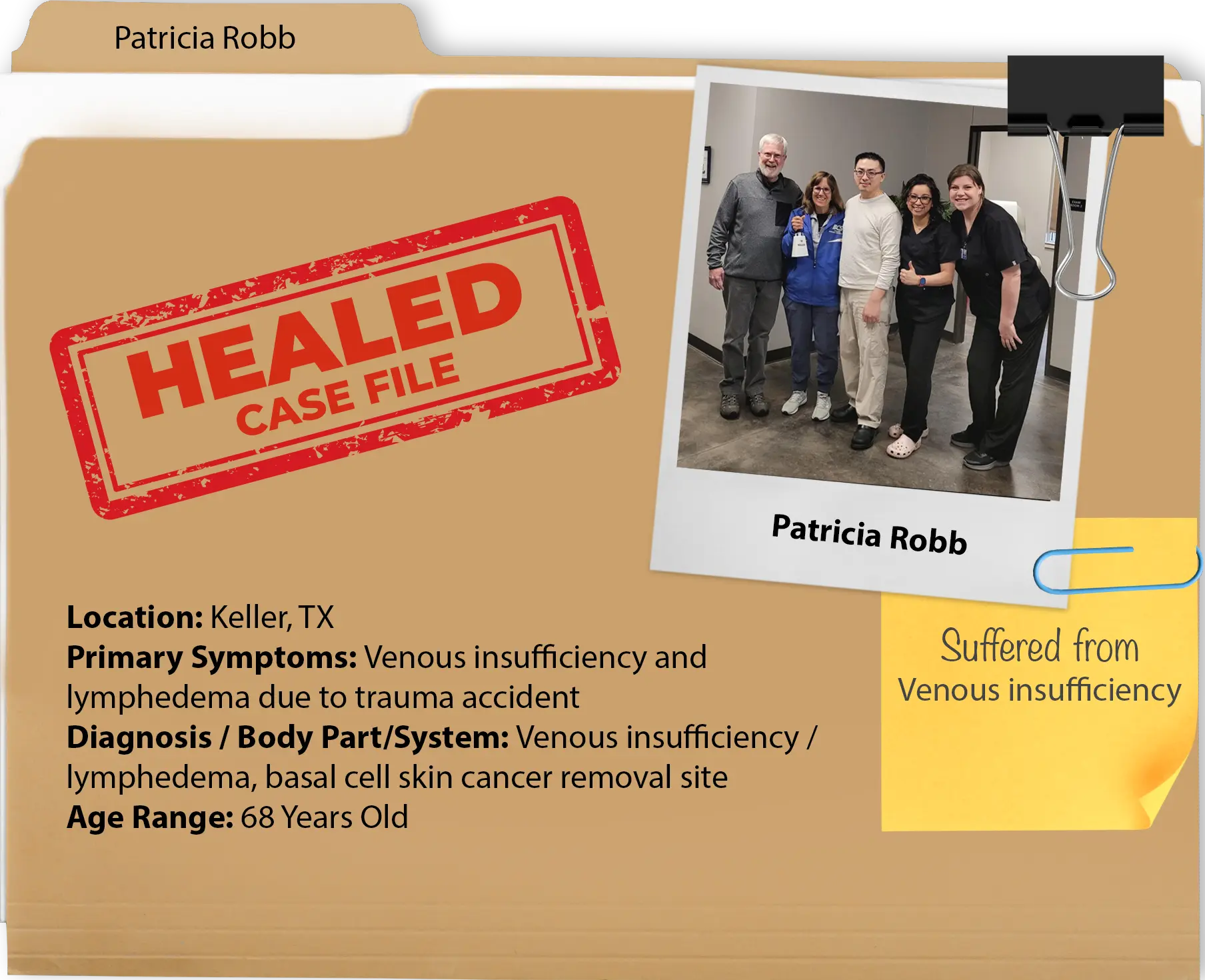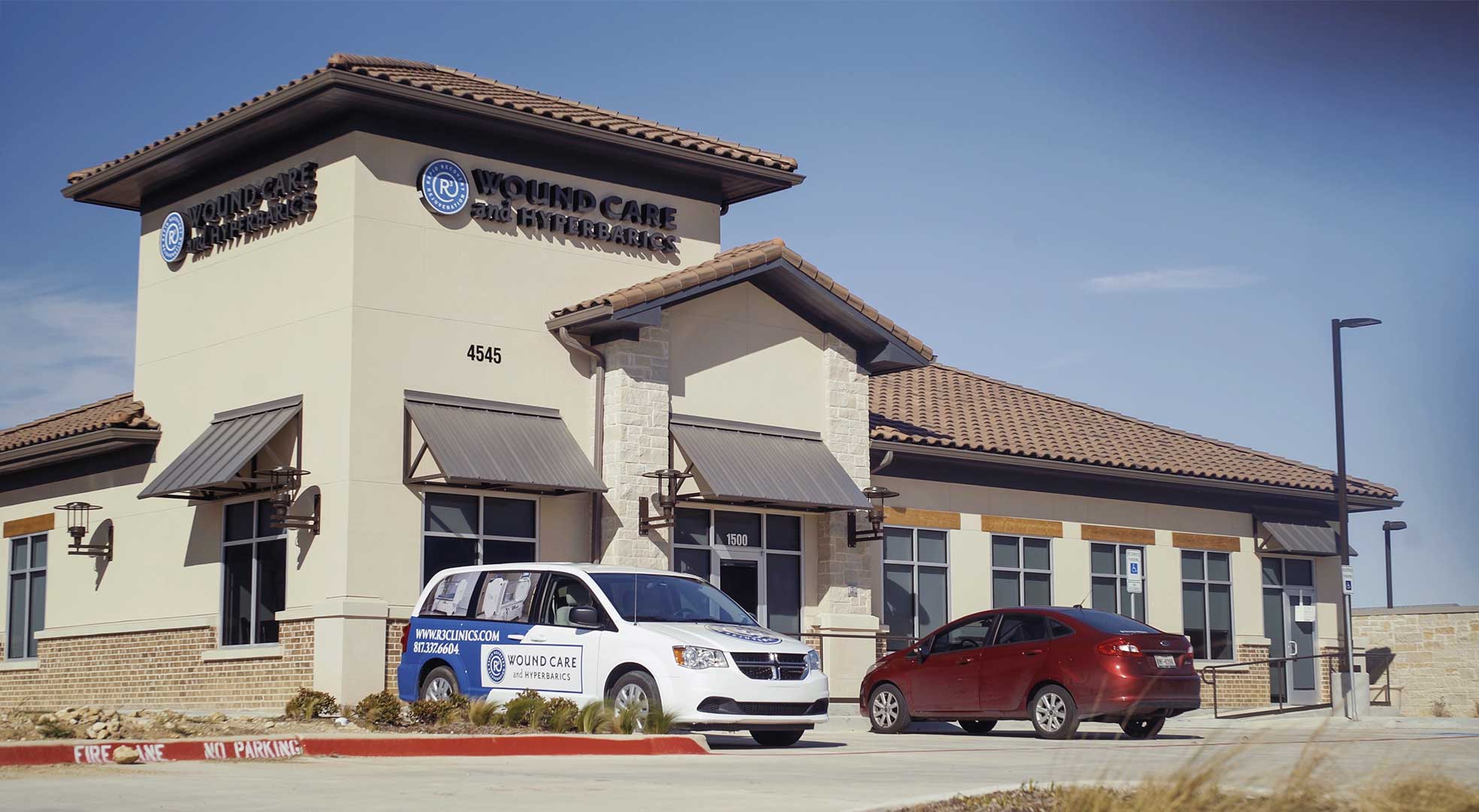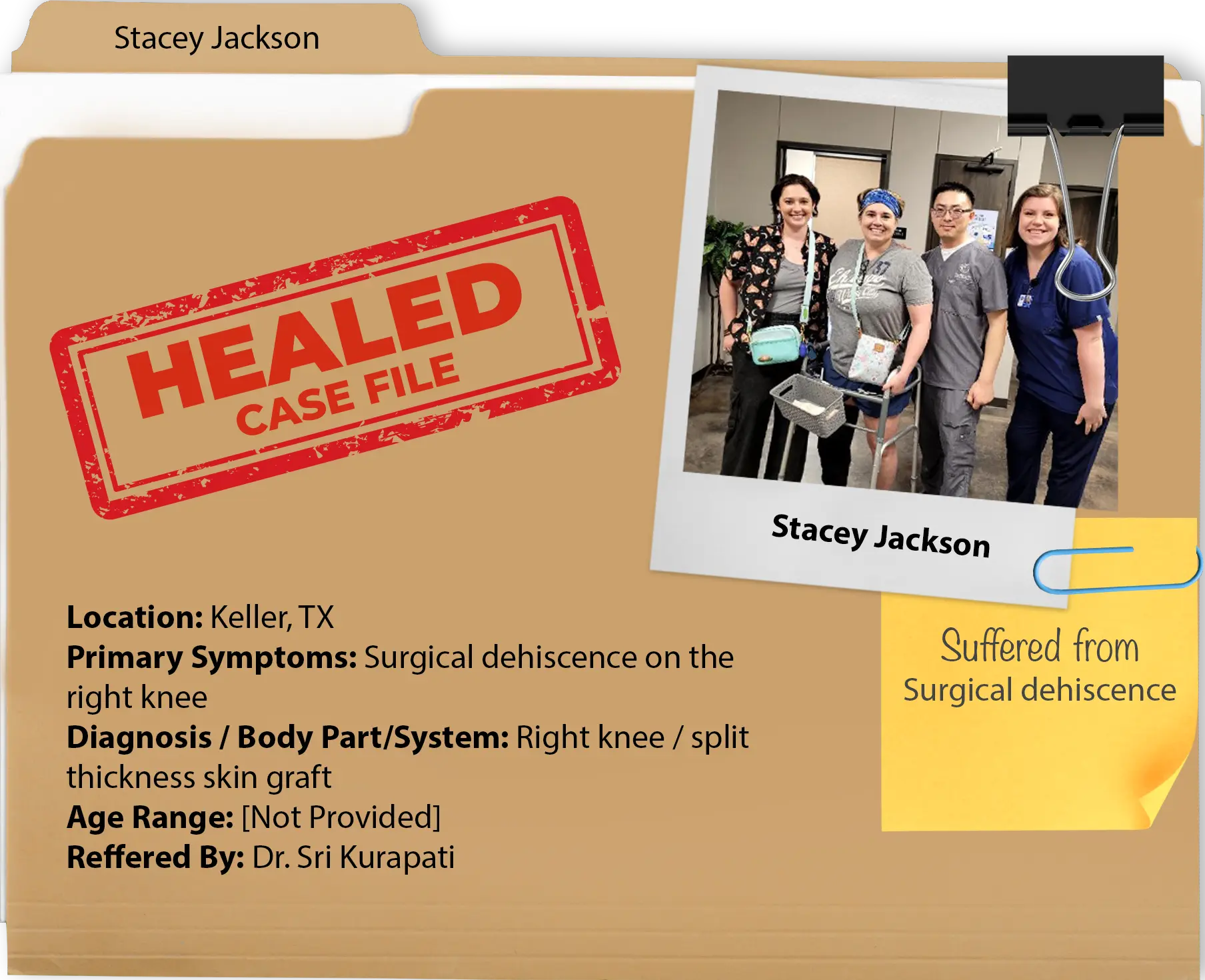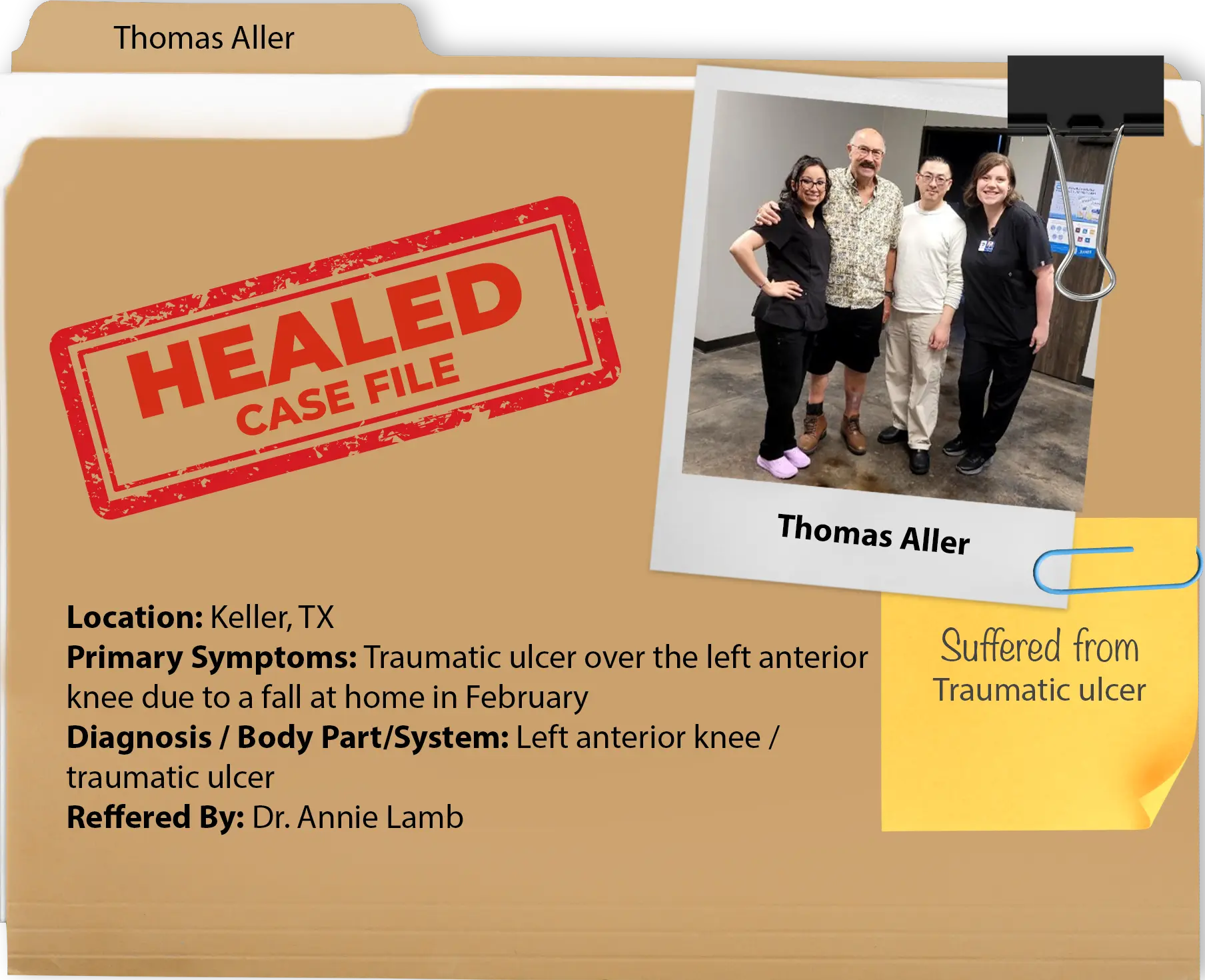
Patricia Robb’s Healing Story
Schedule A Consultation! Robb’s Story A Challenging Diagnosis Meet Patricia Robb, a dedicated 68-year-old PE teacher from Keller. Constantly on her feet, Patricia faced a daunting health challenge following a

Meet Patricia Robb, a dedicated 68-year-old PE teacher from Keller. Constantly on her feet, Patricia faced a daunting health challenge following a traumatic accident in October 2023. She developed a combination of venous insufficiency and lymphedema, which significantly impaired her ability to heal. Complicating her condition further, she underwent a procedure to remove basal cell skin cancer from the same leg, resulting in a stubborn ulcer that refused to heal.
Patricia’s journey to recovery was fraught with frustration. Despite her compliance and numerous attempts with various treatments, her wound persisted. She sought help from multiple providers without success. When she came to R3 Wound Care, Dr. Song saw her potential for recovery and decided to try a different approach.
Patricia’s treatment plan was multifaceted. Initially, various types of compression wraps and wound care techniques were trialed, but the wound continued to weep and fail to heal, largely due to its position over a varicose vein. Despite consultations and scans revealing no venous insufficiency, the lymphedema posed a significant challenge.
In April, Dr. Shah introduced UrgoClean, a new treatment that proved to be a turning point for Patricia. With this innovative wound care product, her condition began to improve remarkably.
Patricia’s dedication to her treatment and her trust in the R3 Wound Care team were pivotal in her healing journey. Despite the complexity of her condition and the trial and error involved in finding the right treatment, Patricia remained hopeful and compliant. The combination of her determination and the team’s commitment led to a successful outcome.
By April 22, Patricia’s wound was fully healed, marking the end of a long and arduous journey. Her recovery is a testament to the effectiveness of personalized and advanced wound care treatments provided by R3 Wound Care. Patricia continues to express her gratitude for the care and support she received, and her story stands as a beacon of hope for others facing similar challenges.


Schedule A Consultation! Robb’s Story A Challenging Diagnosis Meet Patricia Robb, a dedicated 68-year-old PE teacher from Keller. Constantly on her feet, Patricia faced a daunting health challenge following a

Schedule A Consultation! Jackson’s Story: A Challenging Diagnosis Meet Stacey Jackson, a dedicated resident of Keller. Following a significant reconstructive surgery on her right knee, Stacey developed surgical dehiscence, a

Schedule A Consultation! Thoma’s Story: A Challenging Diagnosis Meet Thomas Aller, a dedicated resident of Keller, who faced a significant health challenge following a fall at home in February. This
Osteoradionecrosis (ORN) occurs when bone tissue dies due to radiation therapy, commonly used to treat cancers in the head and neck region. This condition can lead to exposed bone, causing pain, swelling, and infections. It is a rare but serious complication, with the head and neck area being particularly susceptible due to its complex structure and the impact of radiation on blood supply to the bones. Advances in radiation techniques and better care have reduced the incidence of ORN, but it remains a significant concern for patients undergoing radiation treatment for head and neck cancers. High doses of radiation, repeated treatments, and compromised blood supply are typical causes. Treating ORN involves several strategies focused on managing pain, controlling infections, and removing dead bone tissue.

Pain management often includes medications like NSAIDs or opioids. Infection control is crucial, with antibiotics or antifungal medications used to treat or prevent infections. Surgical debridement may be necessary to remove dead bone tissue, promoting healing and reducing complications. In severe cases with significant tissue loss, flap reconstruction surgery might be needed. Supportive care, including proper oral hygiene, good nutrition, and quitting smoking, is also essential in managing ORN and aiding recovery. Prevention strategies emphasize dental care and minimizing radiation exposure to healthy tissue as much as possible.
Hyperbaric oxygen therapy (HBOT) is believed to provide a better solution for osteoradionecrosis (ORN) through several mechanisms:
Hyperbaric Oxygen Therapy (HBOT) involves breathing pure oxygen in a pressurized chamber. This process increases the oxygen level in your blood, which helps to accelerate the body’s natural healing processes. It’s particularly effective for wounds that are slow to heal due to diabetes or radiation injury.
HBOT can also aid in fighting certain types of infections and improving conditions like stroke, carbon monoxide poisoning, and more. Essentially, by enhancing oxygen delivery to damaged tissues, HBOT fosters a better environment for recovery and healing.
It’s like a super boost of oxygen for your body. It helps your blood carry more oxygen to your body’s tissues, which can speed up healing for wounds that take their time or help with other health issues.
Basically, it’s a very innovative way to tap into your body’s natural healing powers!
Hyperbaric Oxygen Therapy (HBOT) is really versatile in treating a wide array of conditions. It’s a solution for speeding up the healing of chronic wounds, especially those tricky ones related to diabetes or injuries from radiation therapy.
Beyond wound care, HBOT helps in treating serious infections like gangrene by boosting oxygen levels to combat bacteria. It’s also effective for people dealing with the aftermath of carbon monoxide poisoning, aiding recovery from strokes, and even tackling sudden severe hearing loss.
The therapy works wonders by increasing oxygen delivery to injured or affected areas, promoting faster and more efficient healing processes.
HBOT is generally considered safe, but like any medical treatment, it comes with some potential side effects. The most common ones are mild and might include feelings of claustrophobia in the chamber, temporary changes to your vision, and ear pressure similar to what you feel on an airplane.
More serious side effects are rare but can include oxygen toxicity or barotrauma to the ears or lungs if not properly managed. R3 safety standards exceeds those of the [FILL IN HERE]
The number of HBOT sessions needed can vary widely depending on the condition being treated and how your body responds. Typically, a treatment plan might include sessions 5 days a week for a few weeks.
Some conditions might see improvement after 20-30 sessions, while more complex issues could require more. It’s really about how your specific situation responds to the therapy.
We invite you to schedule an appointment with an R3 care member to help review your specific situation so that we can help facilitate and aim for the best outcome for you.
Yes, HBOT can be used alongside other treatments. It’s often part of a broader treatment plan, especially for conditions like non-healing wounds, where it complements traditional wound care, or in cases of radiation injury, where it can aid in recovery alongside other medical interventions.
Your healthcare team will assess how HBOT can fit into your overall treatment strategy to ensure the best possible outcomes.
During your first HBOT session, you’ll relax in a chamber where the pressure is increased, allowing you to breathe in pure oxygen. It’s a calm experience, and you might feel a bit like you’re on an airplane as your ears adjust to the pressure changes. The session typically lasts about 90 minutes, during which you can rest or even sleep.
Your R3 Care Team member will carefully monitor you throughout to ensure everything goes smoothly and to make you as comfortable as possible.
Before undergoing HBOT, you’ll likely be advised to wear comfortable, cotton clothing to the session and avoid using any petroleum-based products, as oxygen can be highly flammable.
It’s also important to communicate with your healthcare provider about any medications or supplements you’re taking, as some might influence your treatment.
They may also recommend not eating a heavy meal right before your session to avoid discomfort.
Your R3 Care Team member will give you specific instructions tailored to your health and the specifics of your HBOT treatment.
The timeline for seeing results from HBOT can vary based on the condition being treated and your individual response to therapy. Some people notice improvements after a few sessions, while others may take longer.
Chronic conditions might require more sessions to see significant changes. Your R3 Care Team member will track your progress and adjust your treatment plan as needed.
It’s important to maintain open communication with your medical team and follow their guidance throughout your HBOT journey.
Insurance coverage for HBOT treatments varies widely depending on your provider and the condition being treated. Some insurance plans cover HBOT for specific FDA-approved conditions, while others may not.
It’s crucial to check with your insurance provider directly to understand your coverage details. Additionally, discussing with the R3 Care team can also help, as they often have experience dealing with insurance companies and can offer guidance on navigating coverage issues.
R3 Wound Care prioritizes patient safety and comfort during HBOT by adhering to strict safety protocols, using state-of-the-art hyperbaric chambers, and ensuring all treatments are supervised by trained healthcare professionals.
Your R3 Care team will provide clear instructions on what you can expect and how to prepare for each session, ensuring a comfortable and secure environment.
The R3 Care team is committed to making each patient’s experience as smooth and reassuring as possible, addressing any concerns and monitoring patients closely throughout your treatment.
Insurance coverage for HBOT treatments varies widely depending on your provider and the condition being treated. Some insurance plans cover HBOT for specific FDA-approved conditions, while others may not.
R3 Wound Care prioritizes patient safety and comfort during HBOT by adhering to strict safety protocols, using state-of-the-art hyperbaric chambers, and ensuring all treatments are supervised by trained healthcare professionals.
Your R3 Care team will provide clear instructions on what you can expect and how to prepare for each session, ensuring a comfortable and secure environment.
The R3 Care team is committed to making each patient’s experience as smooth and reassuring as possible, addressing any concerns and monitoring patients closely throughout your treatment.
WOUND CARE AND HYPERBARIC OXYGEN THERAPY
Located in The Dallas-Fort WORTH, Houston and San Antonio Areas of Texas